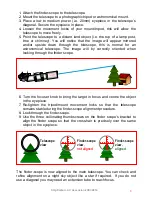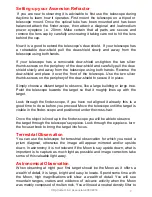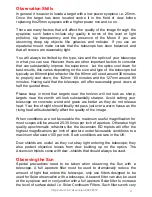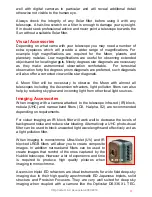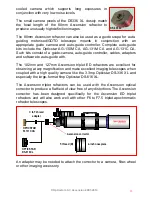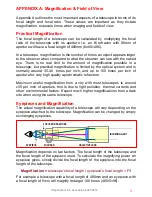
© Opticstar Ltd / Ascension 2007-2014
15
APPENDIX A: Magnification & Field of View
Appendix A outlines the most important aspects of a telescope in terms of its
focal length and focal ratio. These values are important as they dictate
magnification, exposure times when imaging and fields of view
.
Practical Magnification
The focal length of a telescope can be calculated by multiplying the focal
ratio of the telescope with its aperture i.e. an f6 refractor with 80mm of
aperture will have a focal length of 480mm (6x80=480).
In a telescope, magnification is the number of times an object appears larger
to the observer when compared to what the observer can see with the naked
eye. There is no real limit to the amount of magnification possible in a
telescope, but practical magnification is limited by the optical system and is
normally around 35-40 times per inch, and up to 100 times per inch of
aperture for very high quality apochromatic refractors.
Maximum useful magnification from a city with most telescopes is around
x35 per inch of aperture, this is due to light pollution, thermal currents and
other environmental factors. Expect much higher magnifications from a dark
site when using the same telescope.
Eyepieces and Magnification
The actual magnification capability of a telescope will vary depending on the
eyepiece attached to the telescope. Magnification can be changed by simply
exchanging eyepieces.
Magnification depends on two factors. The focal length of the telescope and
the focal length of the eyepiece used. To calculate the magnifying power an
eyepiece gives, simply divide the focal length of the eyepiece into the focal
length of the telescope.
Magnification =
telescope’s focal length / eyepiece’s focal length = F/f
For example a telescope with a focal length of 480mm and an eyepiece with
a focal length of 5mm will magnify its target 100 times (480/5=96).
O
f
F
FOCUSER
FOCUSER DRAWTUBE
OBJECTIVE LENS
EYEPIECE
INCOMING LIGHT








